In This Article
Pressure-Treated Decking
Decay-Resistant Species
Tropical Hardwoods
Hardwood Installation & Finishing
Decking Comparison Chart
See also Composite & Plastic Decking View all DECK & PORCH Articles
Most homeowners still prefer real wood decking. In choosing a decking material, look beyond its short-lived original condition to its appearance and maintenance needs down the road. Whatever material you choose, use the best grade you can afford. With wood decking, select tight, straight grain, few if any knots, and low moisture content. Since most wood decking materials are graded only for appearance, the grading is unregulated and grade names may be confusing. It is best to see a sample before committing to a purchase.
PRESSURE-TREATED DECKING
Pressure-treated decking is still the most common choice due to its low cost and wide availability. As with other pressure-treated lumber products, CCA has been phased out in favor of wood treated with copper quat (ACQ) and copper azole (CA), and other copper-based preservatives.
Most builders in the eastern United States choose nominal 5/4×6 in. radius-edge (RED) decking, which is milled to 1 inch thick and can span 16 inches. The radiused edges on RED stock make an attractive deck surface and help prevent splintering. Western softwoods are typically sold as 2×4 or 2×6 stock and can span up to 24 inches. For fully exposed decks, particularly those with south-facing exposure, use the best grade available, generally called Premium in southern yellow pine and western species. Since these are appearance grades rather than structural grades, the grading and naming are driven more by marketing than engineering.
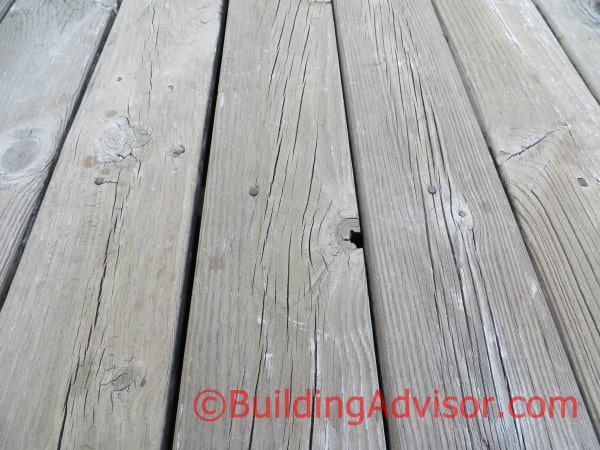
Look for kiln-dried lumber with a factory-applied water repellant, which helps protect against weathering and surface cracks, called checking. Even the best stock, however, should get a fresh coat of a water-repellent preservative (WRP) or deck stain as soon as the wood surface is dry enough to accept a finish.
Many homeowners grow unhappy with pressure-treated decking when they discover that it must be treated regularly to prevent cupping, checking, and warping. It will not rot or get eaten by bugs, but it will crack and eventually fall apart if not maintained. It also provides a good host for mold and mildew growth if not periodically cleaned.
Except where the decking is under a roof and well protected from sun and rain, it must be treated with a water-repellent preservative or stain to prevent problems. It is important to finish the wood as soon as the surface is dry but before it has a chance to start surface cracking (called “checking”), allowing water to penetrate and do further damage. A few premium products are factory-pretreated with a sealer that has penetrated the wood surface and should outlast on-site sealing.
Also, be aware that the copper-based preservatives now used in pressure-treated wood are very corrosive to aluminum, steel, and other metals. It’s important to use corrosion-resistant fasteners and metal connectors approved for use with pressure-treated wood. For critical connections, consider upgrading to stainless-steel. It’s expensive, but you’ll never have to replace them and you can sleep at night without worrying about deck failure.
Read more about the Durability and Longevity of Treated Wood
DECKING MATERIAL COMPARISON |
||||
| Decking materials | Pros | Cons | Costs 1-low 5-high |
Recommendations |
| Pressure-treated yellow pine | Inexpensive, strong, durable. Readily available in eastern states. | Pressure-treatment corrosive to metal fasteners. Prone to check, crack, cup, and splinter | 1 | Economical choice for typical projects. Use premium-grade, KD, radius-edge decking (RED). Treat with water-repellant preservative after installation to prevent checking. |
| Pressure-treated hem-fir |
Strong, durable. Readily available in western states. | Pressure-treatment corrosive to metal fasteners. Cuts and drilled holes need treatment. | 1 | Economical choice for typical projects. Choose a visual grade intended for decking use. Treat all field cuts and drilled holes with copper-naphthenate. Treat with water-repellent preservative. |
| Pressure-treated Douglas fir | Very strong, durable. Available in western states | Pressure-treatment corrosive to metal fasteners. Cuts and drilled holes need treatment. | 2 | For applications where high strength is required. Choose a visual grade intended for decking use. Treat field cuts and finish as above. |
| Redwood | Heartwood naturally decay-resistant. Attractive and easy to work with. | Splinters easily. Soft wear surface. Sapwood vulnerable to decay. Needs regular treatment with stain to retain color. Galvanized fasteners stain. | 3-4 | For high-end projects requiring natural materials. Use an all-heart grade, if available. Treat after installation with water-repellant preservative. Use stainless-steel screws. |
| Cedar | Heartwood is naturally decay-resistant. Attractive, readily available | Sapwood vulnerable to decay. Soft wear surface (western cedar). Needs regular treatment with stain to retain color. Galvanized fasteners stain. | 3-4 | For high-end projects requiring natural materials. Use an all-heart grade of western red, Port Orford, northern white, or Atlantic white cedar. Treat as above. Use stainless-steel fasteners. |
| Tropical hardwoods | Naturally decay-resistant. Hard, durable, and long-lasting. Tight grain resists water intrusion. Attractive, readily available. | Heavy, hard material. Dulls tools. Pre-drilling required. Dust irritates skin and lungs of workers. Ipe checks at end cuts if not sealed. Needs regular treatment with penetrating oil finish to retain color. Environmental concerns. | 4-5 | High-end projects requiring natural materials. Either screw and plug or use recommended hidden fasteners. Treat upon installation with a UV-blocking sealer. To preserve wood color, treat periodically with a penetrating oil finish. Use stainless steel fasteners. |
| Wood-plastic composites | Durable.Low maintenance Some use 50–100% post-consumer wood flour and plastics. Looks and feels similar to wood. | Spans limited to 16 inches. Somewhat bouncy feel. Standard nails and screws leave pucker when set. Oil and grease can stain. Some products have plastic appearance. | 2-4 | For moderate budget projects requiring low maintenance. Use as an alternative to treated lumber. Do not exceed recommended span for material. Follow manufacture’s guide to clean and maintain |
DECAY-RESISTANT SPECIES
Until the recent introduction of synthetic decking materials, the only viable alternatives to pressure-treated lumber were naturally decay-resistant wood species, such as redwood and cedar. A number of tropical hardwoods are now available to deck builders as well.
Redwood and Cedar. The most decay-resistant materials are cut from the dense heartwood of old-growth trees, which is expensive and increasingly rare. In redwood, the lighter colored sapwood offers moderate resistance to decay. Cedar sapwood is even less resistant. If possible, choose all-heart grades for exposed areas
The two most commonly used cedar types are western red cedar and Alaska cedar, sometimes sold as Alaska cypress. Western red cedar is relatively soft and easily dented, but dimensionally stable. Yellow cedar is stronger and has a harder surface; but it is prone to shrinkage movement, so it is best purchased kiln-dried. Other less common cedar species suitable for decking include Port Orford cedar, a strong, dense wood from southern Oregon, and Northern white and Atlantic white cedar.
Redwood and cedar should, at a minimum, be treated regularly with water repellents to protect against cupping, checking, and cracking. Occasional treatment with a water-repellent preservative will increase the service life. Even then, the wood will weather to a silver gray like nearly all wood decking products.
For clients who want to preserve the original wood color, the best option is to use an oil-based semitransparent stain with pigments that resemble the desired color. It may seem strange to red-cedar wood with a red-cedar stain, but that’s about the only way to retain something close to the original wood color.
For those who can afford it, all-heart redwood, shown above, or all-heart clear cedar provide natural beauty and decay-resistance. The sapwood of these species, however, is vulnerable to decay.
TROPICAL HARDWOOD DECKING
A number of tropical hardwoods are becoming increasingly available as decking materials in the US, typically sold as nominal 1×4 and 1×6 stock which can span 16 in. and 5/4×6, which can span 24 in. With the denser materials, nominal 1 in. stock is fine for most residential uses.
While once considered and ultra high-end product, prices have come down, putting a tropical hardwood deck in the same price range as premium composite and plastic decking. Lower-cost hardwoods, like red meranti can price out below some synthetics.
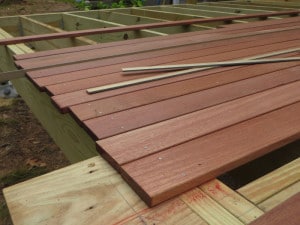
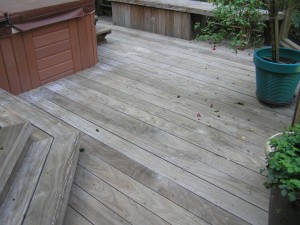
Hardwood Choices: All tropical hardwoods are not alike. Buying tropical hardwoods can be confusing as the same species may be sold under different names or even grouped with similar species for marketing purposes. In general, however, all these woods will outlast the redwood and cedar available today and should require only periodic treatment with a UV-blocking water repellant or a penetrating oil finish.
Each wood has unique characteristics that effect installation, finishing, and performance. Dealing with a reputable supplier or deck contractor is important as wood quality and performance can vary considerably. The best performing species are very strong, dense, and hard, and very resistant to decay and insects, making them ideal for deck surfaces. The hardest, densest woods are the most durable and most difficult to work and install. Availability varies around the country. Commonly available species include:
Ipe. The first choice for many – and most expensive – is Ipe, a dark brown, oily wood that is extremely dense and stable that will last 40 years or more if reasonably maintained. Because of its durability, Ipe has been used on a number of large municipal projects including the New York City High Line.
Cumaru is nearly as hard, dense, and durable as Ipe, but often 30-40% less expensive. Also called Brazilian Teak and Brazilian Chestnut, it has a yellow-brown color and streaked grain pattern.
Red Balau is a hard, dense wood with excellent resistance to rot and insects. It is a rich red color that is fairly consistent from piece to piece.
Garapa is another hard, dense wood with excellent resistance to rot and insects, but a much lighter color.
Tigerwood is a rich reddish-colored wood with dark streaks. It is less hard and dense than Ipe, but still a very durable, rot-resistant, and long-lasting wood.
Meranti. Typically sold widely as mahogany or “dark red meranti,” this dark reddish wood is in the same family as lauan or Philippine mahogany. Meranti is closer to pressure-treated softwood decking in hardness and is moderately resistant to decay and insects, similar to redwood and cedar. Less expensive than other tropical hardwoods.
Cambara is a similar mahogany-like wood with pricing and performance similar to Maranti, but lighter in color. It is moderately resistant to decay and dry-wood insects, but vulnerable to termites.
With hardwood decking, the performance of each product depends on the grade of wood used, its moisture content when installed (and whether it is air-dried or kiln dried), how it is fastened and finished, and its exposure to direct sunlight. None of these woods is impervious to cupping, checking, and surface weathering, and all are more difficult to finish than domestic woods because of their density and natural oils.
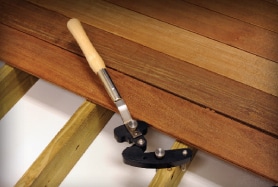
If the budget allows choose a good grade that’s dry – preferably kiln dried – and that’s knot-free with tight grain which helps keep out water. Higher grades and drier boards are less likely to warp, cup, and check. Plan on using a sturdy board straightening tool during installation and cutting up or discarding any seriously warped boards.
With all tropical hardwoods, there are valid concerns about the wood’s origin and the impact of its harvesting on the world’s rainforests. Fortunately, there are established third-party certification organizations that track the “chain of custody” of hardwood products and certify that they were harvested using sustainable logging practices. Finding certified tropical hardwoods can be difficult, however, and the issue remains controversial among green building advocates. Contact the Forest Stewardship Council for more information.
Hardwood Decking Installation
Expect hardwood installation to take longer, destroy many blades and bits, create irritating dust, resist finishing, and look beautiful in the end if you take your time and do it right. Some key tips:
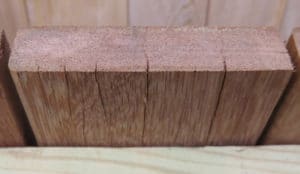
Seal end cuts. Most hardwood decking from the mill needs end cuts. To prevent cracking, all end cuts should be sealed with three or more coats of the same oil used to finish the surface, or a specialty wax sealer for hardwood decking such as Anchorwood or Ipe Seal. If you use a wax sealer, be careful not to stain the face of the board. Also pre-drill for face screws and keep a safe distance from the end cuts.
Protect skin and lungs. Hardwood dust can be irritating to skin and lungs. Wear gloves, long-sleeve shirt, and an N95 dust mask when cutting. Also keep plenty of carbide blades and bits on hand.
Discard warped boards. Ipe and very dense hardwoods will resist your efforts to straighten. You might be able to cut and use the shorter pieces. Plan to use a sturdy board pulling tool such as the BoWrench or Ipe Wrench.
Use stainless-steel screws. Attach with stainless-steel screws after pre-drilling. Using Torx- or square head screws will save you a lot of stripped screw heads. Use colored screws to match or, for a cleaner look, countersink and plug with matching hardwood plugs. Glue plugs with a polyurethane-based adhesive and shave the top with a chisel. Finally sand the deck with 60 and then 80-grit for a perfect finish.
Order pre-grooved. Hidden fasteners can be used with very dimensionally stable woods such as Ipe. Order the wood pre-grooved to match the fastening system. Popular systems include the TigerClaw, by Fastenmaster, and the Ipe Clip. You may need to discard or cut up warped boards.
Gap boards correctly. As a rule of thumb, gap kiln-dried boards 1/8”, air dried, 1/16in. and wet wood can be butted tight, especially where it will be exposed to direct sun much of the day.
Tight butt joints. At butt joints, put a small 2-3 degree bevel on end cuts and install with the long ends up. This creates an attractive seam with a good gap for drainage.
Avoid metal stains. Many hardwood species will react with almost any metal, even small shards, and leave black spots. So sweep regularly and recommend that customers use plastic feet on furniture.
Finishing Hardwood Decking
End-grain sealing. Because of its dense grain, hardwood decking is very prone checking (cracking) at cut ends. These small cracks will get worse over time, especially in freezing climates where water can penetrate into the cracks and freeze. To prevent this problem, it is important to seal all cut ends of hardwood decking as soon as it arrives on the job site and as soon as any cross-cuts are made. A variety of end-grain sealers that combine wax and penetrating oils are sold wherever deck stains are available. Some installers prefer to use multiple coats of the same finish used on the surface.
Some end-grain sealers include applicators (like oversized shoe polish brushes) that simplify applying the coating. The trick is to get it just on the end-grain without spilling onto the surface of the board. This may leave a small stain or discoloration on the end of the board that might bother some homeowners.
Penetrating oil. Finish hardwood decking with a UV-blocking penetrating oil specially formulated for hardwoods. Regular deck finishes may be too thick to absorb properly. The surface should be dry enough to absorb drops of water or clear oil sprinkled on the surface. Depending on the type of wood, apply one to three coats. On Ipe and other very dense woods such as Cumaru, apply only a single coat, being careful to wipe away any excess stain in 15-20 minutes. Otherwise you will end up with a sticky mess since the wood is so dense that very little will be absorbed.
Popular hardwood finishes include Messmer’s UV Plus, Ipe Oil, Sikkens Cetol Deck Finish, Penofin Penetrating Oil Finish for Hardwood, and Cabot Australian Timber Oil (the original penetrating oil formula). I prefer a “natural” finish, but if you want more color, choose a finish pigmented to match the wood, such as Cabot’s Mahogany Flame.
True penetrating oil finishes are getting harder to find in some markets due to VOC regulations. Some companies offer two versions of the same finish. For example, Cabot sells a low-VOC “oil-modified” version of Australian Timber Oil that cleans up with water. Don’t expect the same type of penetration or protection that you get with a true penetrating oil.
Re-coat or let it weather? For a silver-gray look, you can let Ipe and other tropical hardwoods weather after the first coat, with an occasional deck wash as needed. To maintain something close to the original dark color, you will need to clean and recoat annually with direct sun exposure or a lot of tree debris. Softer woods will need cleaning and retreatment every 1-3 years depending on sun exposure and wear.
If you have let a hardwood deck go for several years, you can usually restore it to a new appearance by cleaning, sanding, and refinishing.
Theresa says
Carpenter Bees Attacking YellaWood
I am very unhappy with the YellaWood deck boards. I had pressured-treated boards installed less than a year ago to keep Carpenter bee from drilling into the decks. The bees are already drilling holes so, the boards must not be treated well. Now I will have to paint. 😡
buildingadvisor says
YellaWood is treated with one of the newer copper-based preservatives called MCA (micronized copper azole). Copper-based preservatives were introduced when the treated wood industry voluntarily withdrew CCA-treaded lumber (chromated copper arsenate) in the early 2000s due to health concerns about the arsenic content.
The second-generation of these preservatives (MCA and MCQ), use very fine particles of copper in the treatment solution, with the goal of making the wood less corrosive to metal.
It achieved this goal, but some of MCA’s competitors claimed in their marketing that MCA-treated lumber was less effective against bugs and wood decay. The competitors backed off from these criticisms of MCA after a lawsuit was filed claiming their research data was flawed.
Others claim that all of the copper-based preservatives are less effective than the old pre-2000s CCA. There is anecdotal evidence and some research to support this conclusion.
Another issue is that carpenter bees do not eat wood – they bore small holes into the wood to lay eggs. The damage is usually quite limited and rarely structural. While carpenter bees prefer soft, unfinished wood, they will sometimes bore into pressure-treated wood. The 1/4-in-diameter holes are easy to treat with insecticide such as wasp and hornet spray. Once you’ve treated the holes and let them dry, you can fill them with an exterior wood filler.
You mentioned painting the wood. That might keep out the carpenter bees, but paint won’t last long on horizontal wood such as decking and may even hasten decay by trapping moisture in the wood. Instead apply a high-quality decking stain or water-repellant preservative to the decking. Depending on the sun exposure and usage, plan to reapply every 1-2 years for best performance and a long lifespan for the decking.
Read more on the Lifespan of Treated Wood Decks
Susan LEW says
Anyone Used Ipe Decking?
Question: Has anyone used Ipe decking and frame. Sounds like a good product/material. How do you find a proficient installer; from what I have read, this is not to be installed, treated, cleaned like a ‘regular’ deck material. MUST read the instructions thoroughly. Advantage Lumber seems to be most knowledgeable supplier, but they are in NC and I am in MO.
buildingadvisor says
I have installed Ipe and other hardwood decking types. Ipe is about the hardest and densest wood used for decking and is not easy to work with. It creates noxious dust,, requires pre-drilling, end sealing, and special hardwood finishes for good performance.
The benefit is an extremely durable deck that will give many years of service with relatively little maintenance. If you want to maintain the dark tropical wood color, you will need to refinished the deck regularly. If you are happy with a weathered gray appearance, you will only need to periodically clean the deck surface as you need to do with any deck.
Read more about installing and finishing ipe and other hardwood decking.
Most deck builders today have experience with tropical hardwoods, so it shouldn’t be difficult finding a competent installer. Just make sure you check references and visit a couple of jobs that have been in place for at least a year or two.
Best of luck with you new deck!
Decking wood types says
Kebony, New Type of Treated Wood
Here is one more suggestion to you. Kebony is a non-toxic, durable, biologically inert product, and can also be used for cladding, roofing, windows, indoor and outdoor furniture etc.
Joe Kress says
Flashing Tape to Protect Deck Joists
I hear there is a material available in rolls that can be used to cover the upper surface of deck joists that will be exposed to rain & snow melt. My 2×8 fir joists are rotting from winter snow melt.
When replacing joists I need a material that will prevent the rotting. The product is cut in strips and adheres to the upper surface of the joists. Do you know the name of this new product and where it can be purchased. Thanks
buildingadvisor says
The product you are looking for is often referred to as “joist flashing tape”. The first product marketed for this use was Vycor Deck Protector, from Grace Building Products. If you Google “joist flashing tape” you will find others, including some sold by discount home centers.
These are the same flashing membranes that are used around windows and doors, but marketed for use with deck joists. With pressure-treated lumber they are sometimes used to isolate the lumber from steel connectors, which are prone to corrosion when in contact with the newer types of pressure-treated lumber.
If you are replacing the deck joists, you are best off using pressure-treated lumber. With pressure-treated lumber, you should not need to protect the top surface from rot. However, you might still want to use the flashing tape to keep the wood from directly contacting steel connectors such as joist hangers. The formulations currently used in pressure-treated lumber are very corrosive to steel.
However, if the existing joists are still usable, flashing tape should extend their life. You should also apply a wood preservative, and let it dry fully, before applying the tape. The best preservatives are the ones rated for ground contact, such as Cuprinol #10 Green and Woodlife CopperCoat.